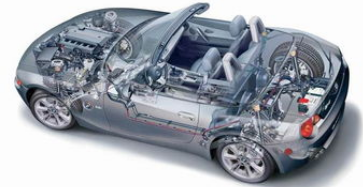What are the sensors used in cars?
The sensor on the car is the information source of the car's electronic control system, a key component of the car's electronic control system, and one of the core contents of research in the field of car electronics technology. Automotive sensors measure and control real-time and accurate information on temperature, pressure, position, speed, acceleration, and vibration. The following describes the core of sensors in automobiles, engine control sensors, and several new sensor products.

The engine management system uses various sensors and is the core of the entire automotive sensor. There are many types, including temperature sensors, pressure sensors, position and speed sensors, flow sensors, gas concentration sensors, and knock sensors. These sensors convert the engine intake air volume, cooling water temperature, engine speed, acceleration and deceleration into electrical signals and send them to the controller. The controller compares this information with the stored information and calculates the control signal accurately. The engine management system can not only accurately control the fuel supply to replace the traditional carburetor, but also control the ignition advance angle and idle air flow, which greatly improves the performance of the engine.
With the development of the automobile industry today, there are more sensors on the car, and the characteristics of the sensors also make the car more intelligent. For example, the tire pressure monitoring system installs a miniature pressure sensor in each wheel frame to measure the air pressure and The wireless transmitter transmits information to the driver. When the tire pressure is too low, the system will automatically issue an alarm to remind the driver to deal with it in time. This will not only ensure the safety of the car while driving, but also protect the tread, extend the life of the tire and achieve fuel saving purposes.
The tire pressure monitoring sensor can accurately measure the tire pressure and temperature and transmit this information to a receiver installed in the car via wireless signals. Air pollution in vehicles now poses a new threat to the health of car owners, and this threat mainly comes from carbon monoxide. With the rapid increase in the number of car owners, the air quality in the car has begun to attract attention. Carbon monoxide sensor has the characteristics of high sensitivity, strong anti-interference, low power consumption, etc., and is specially used to ensure the safety of air quality in the car. At the same time, the application is simple and the service life is long, which can timely monitor the air quality in the car. The carbon monoxide sensor is divided into an automatic switching system for the internal and external circulation of the air conditioner in the car, and a carbon monoxide alarm for cars and passenger cars.
At the People and Vehicle Technology Exhibition 2003, a tilt sensor for vehicle anti-theft was displayed. The angle sensor uses a 2-axis acceleration sensor to detect the tilt of the vehicle caused by the vehicle being lifted during the theft in time and issue an alarm. This acceleration sensor is an electrostatic capacity formula. In April 2003, the British Insurance Association decided to provide preferential insurance for vehicles with anti-theft angle sensors.
Similar promotions will also be launched in Japan where the number of vehicle thefts is increasing, and it is estimated that the market demand for angle sensors will become increasingly strong. The new thick-film piezoresistive non-contact automotive oil pressure sensor is manufactured with thick-film force-sensing technology and surface micro-assembly technology. It monitors the engine lubricating oil pressure and can realize low oil pressure alarm. It has passed the bench test, type test and 60,000 durability tests, and can directly replace the existing bimetal slide-line YG2221G oil pressure sensor.
Compared with the existing sliding-line oil pressure sensor, it has the characteristics of high accuracy, no mechanical parts contacts, high reliability, long life, corrosion resistance, matching with digital instruments, low cost, and high cost performance. It is not difficult to see that the application of acceleration sensors on automobiles will be the biggest trend in the future automotive industry.
If you want to know more, our website has product specifications for sensors, you can go to ALLICDATA ELECTRONICS LIMITED to get more information

